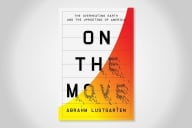You have /5 articles left.
Sign up for a free account or log in.
The Grid: The Fraying Wires Between Americans and Our Energy Future by Gretchen Bakke
Published in July of 2016.
How much do you know about the electrons that are responsible for allowing you to read these words? Where was the electricity generated that is powering your laptop, phone or tablet? How did the electricity get from its source to the servers that store the information of this IHE website? What was the route that the electricity took from generation to (your) consumption?
Answering any of these questions requires us to think about our electrical grid.
How much research and teaching is going on on your campus related to energy? Are we combining engineering and technology challenges related to energy with issues of policy, economics, and equity? Are our colleges and universities, particularly our liberal arts institutions, claiming a seat at the table in our national conversation about the future of how we will produce and consume energy?
A great was to jump start this conversation on campus would be to read and discuss Gretchen Bakke’s absolutely terrific new book The Grid: The Fraying Wires Between Americans and Our Energy Future. Bakke, an anthropologist who teaches at McGill, takes a wide angle view of the grid in this book - bringing both an historical and social perspective to the story of how America produces, transmits, and consumes electricity.
As Bakke points out, our electrical grid is the largest machine ever invented. The U.S. electrical grid (300,000 miles of high-voltage transmission lines), is in reality 3 grids: the Eastern, Western Interconnection, and Texas Interconnection. Power comes from 7,200 generation stations. Traditionally, the U.S. has generated most of its electricity from coal. Today, natural gas and coal are neck-in-neck as sources of electrical generation (think fracking) - with 33% of electricity coming each from both sources. Nuclear accounts for 20% electrical generation. Less than 1% of electricity is generated by oil. That leaves about 13% of U.S. electricity that is generated from renewable sources. Hydro power is accounts for 6% of our electrical generation, wind 4.7%, biomass 1.6% and solar less than 1%.
Reading The Grid is essential if you are enthusiastic about replacing fossil fuels with renewable power. Bakke points out that the depressing numbers sited above about renewable energy are not actually that depressing. Solar and wind may be starting from a low base, but they are by far the fastest growing segment of our electricity generating mix. In 2007 only 1 percent of our electricity came from wind. By the end of this year, that figure will be 5%. Today, over 70 gigawatts of power is produced from wind - enough to supply electricity to over 19 million homes. Solar is also growing quickly, mostly due to a drop of 70% in the cost to install home solar arrays over the past decade. There are over 1 million solar installations on American rooftops - creating the equivalent of 27.2 gigawatts (enough to power 6 million homes). And as Bakke points out, home solar arrays (which feed back into the grid) are not counted in estimates of total U.S. renewable electrical generation.
According to the National Renewable Energy Laboratory, today’s commercially available electricity generation technologies could supply 80% of all U.S. electrical power needs by 2050.
According to Bakke, this transition from dirty fossil fuels to clean renewable energy will not happen unless two things change. The first is that the U.S. needs to upgrade and modernize the electrical grid. Much of the technology that constitutes the grid is over 50 years old, and is in need of replacement. A smart grid, one overlaid by sensors, would enable both early warnings of problems and more efficient load balancing. The number of blackouts is rising as equipment ages, and budgets are cut for maintenance (as utilities struggle to survive given the growth of residential and commercial micro power generation. Since 2010 there has been an average of 100 power outages per year, compared to an average of 43 outages between 2005 and 2010.
The second change that needs to happen is an improvement (really a revolution) in power storage. Today, our electricity consumption needs to be perfectly balanced with our electricity production. We have no large scale way to store power. This is particularly problematic for renewable energy sources, as electrical generation stops when the sun stops shining and the wind stops blowing. There is great enthusiasm for the possibility of storing electricity in our future Chevy Bolts and Tesla’s - or in our basements in a Tesla Powerwall - but neither of these technologies (or any other storage system) is anywhere near grid scale.
Higher ed makes some appearances in The Grid. Many of our campuses generate part of their own energy with co-generation plants - power plants that turn fuel into both heat and electricity. Steam is produced to drive the turbine generators for electricity - and the the backpressure steam from the electrical generation process is used to heat buildings. These campus power plants are hooked into the grid, and can vary the amount of power that they take (or return) to the grid. During blackouts, campuses with their own microgrids can keep the heat on and the electricity flowing - as they can temporarily increase the amount of fuel that they burn. Does your campus have a co-generation plant?
Bakke is deeply committed to a non-carbon, renewable energy future. She is also a realist about the challenges of achieving this vision.
If you, and your students and academic colleagues, are also committed to this renewable energy future - then you should prioritize reading and discussing The Grid.
What other books about energy, energy policy, and the future of energy would you recommend?
I would recommend anything written by Daneil Yergin, including: The Commanding Heights (2002), The Prize (2008) and The Quest (2012). Steve Coll’s 2013 Private Empire: ExxonMobil and American Power offers a sweeping history (and powerful indictment) of the oil industry. The best book of American’s natural gas boom is Russell Gold’s 2014 book The Boom: How Fracking Ignited the American Energy Revolution and Changed the World. A good book on why energy storage innovation is difficult is the 2015 The Powerhouse: Inside the Invention of a Battery to Save the World. If you want to get your blood boiling, read Epstein’s 2014 The Moral Case for Fossil Fuels. And if you want to read a well-reasoned (but I think misguided) counter-argument to a renewable energy future - check out Robert Bryce’s 2014 book - Smaller Faster Lighter Denser Cheaper: How Innovation Keeps Proving the Catastrophists Wrong.
What are you favorite books about energy?
What are you reading?








